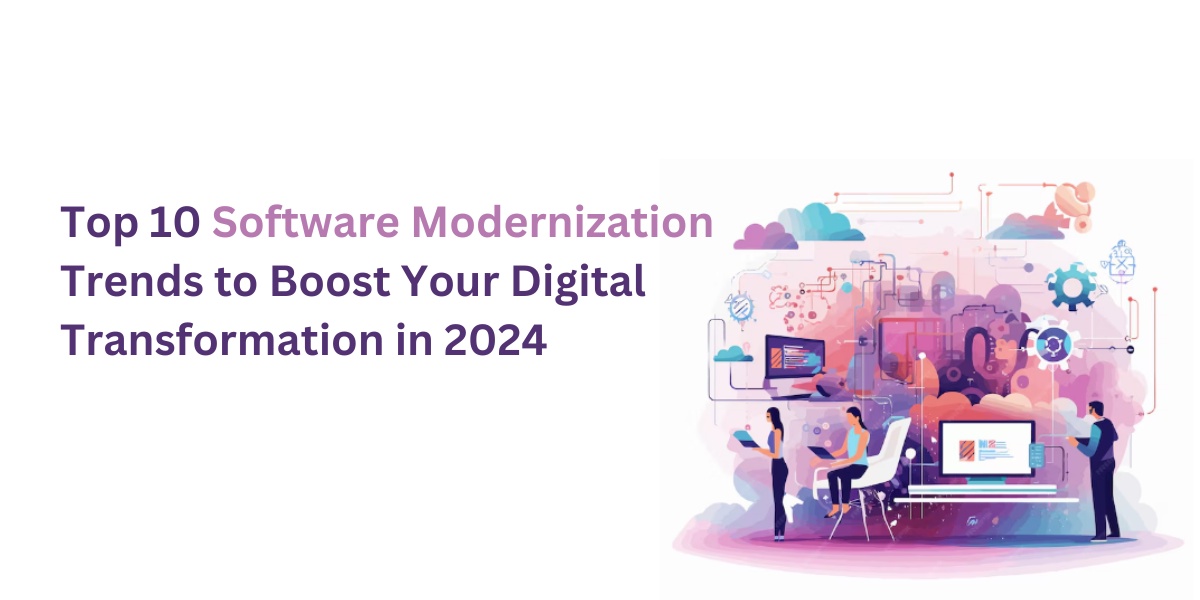Introduction:
In today's rapidly evolving digital landscape, staying ahead of the curve is essential for businesses aiming to remain competitive. Software modernization has emerged as a critical strategy for organizations looking to adapt to changing market demands, enhance efficiency, and drive innovation. In this blog, we'll delve into the top 10 software modernization trends shaping digital transformation in 2024.
What is modern software development?
Modern software development is an approach that emphasizes speed, flexibility, and security in creating and delivering applications. It involves breaking down applications into smaller components, writing code that can run consistently in various environments using containers, and adopting agile methodologies for faster adaptation to market needs. This approach also integrates DevOps practices, continuous improvement, and a focus on business value, linking software development more closely to the impact on the organization. Modern software development is characterized by iterative development, collaboration, and a user-centric design approach, aiming to deliver high-quality software efficiently.
10 software modernization trends
-
Embracing Cloud-Native Technologies:
Cloud-native development enables organizations to build and deploy applications faster, with greater scalability and resilience. By leveraging containerization, microservices architecture, and serverless computing, businesses can streamline their development processes and optimize resource utilization.
-
Agile and DevOps Adoption:
Agile methodologies and DevOps practices continue to gain momentum, allowing teams to deliver software more rapidly and reliably. By fostering collaboration between development and operations teams, organizations can accelerate time-to-market and enhance overall product quality.
-
Legacy System Modernization:
Many enterprises still rely on legacy systems that are outdated and difficult to maintain. Modernizing these systems involves refactoring, rearchitecting, or replacing them with more agile and scalable solutions. This trend enables organizations to unlock new capabilities, improve performance, and reduce technical debt.
-
AI and Machine Learning Integration:
Integrating AI and machine learning capabilities into software applications can revolutionize processes such as data analysis, decision-making, and automation. By harnessing the power of artificial intelligence, businesses can gain valuable insights, optimize operations, and deliver personalized user experiences.
-
API-First Approach:
API-first development focuses on designing APIs before implementing the underlying functionality, enabling greater flexibility and scalability. This approach facilitates seamless integration with third-party services, accelerates development cycles, and promotes a modular architecture.
-
Low-Code/No-Code Platforms:
Low-code and no-code platforms empower citizen developers to create software solutions with minimal coding required. These platforms democratize app development, allowing non-technical users to contribute to digital transformation initiatives and rapidly prototype new ideas.
-
Cybersecurity Prioritization:
As cyber threats become increasingly sophisticated, cybersecurity must be a top priority for organizations undergoing software modernization. Implementing robust security measures, such as encryption, multi-factor authentication, and continuous monitoring, is essential to protect sensitive data and mitigate risks.
-
Focus on User Experience (UX):
In the age of digital transformation, user experience plays a crucial role in the success of software applications. By prioritizing UX design principles, organizations can create intuitive interfaces, streamline workflows, and enhance customer satisfaction.
-
Edge Computing Adoption:
Edge computing brings computing resources closer to the point of data generation, enabling faster processing and reduced latency. This trend is particularly relevant for applications requiring real-time responsiveness, such as IoT devices and immersive multimedia experiences.
-
Continuous Innovation Culture:
To thrive in today's competitive landscape, organizations must cultivate a culture of continuous innovation. By encouraging experimentation, embracing failure as a learning opportunity, and fostering a growth mindset, businesses can stay agile and adapt to changing market conditions.
Conclusion:
Software modernization is a journey, not a destination. By embracing these top 10 trends, organizations can accelerate their digital transformation initiatives, drive innovation, and gain a competitive edge in 2024 and beyond. Whether it's leveraging cloud-native technologies, adopting agile and DevOps practices, or integrating AI and machine learning, staying abreast of the latest trends is essential for success in the digital age.


No comments yet